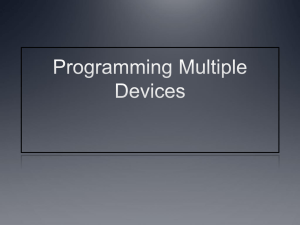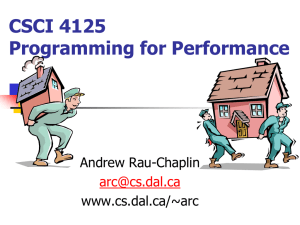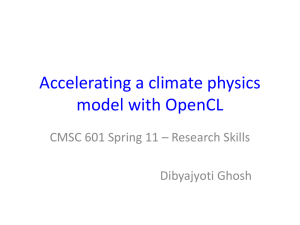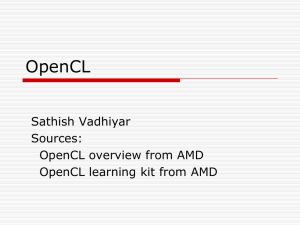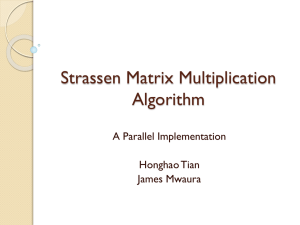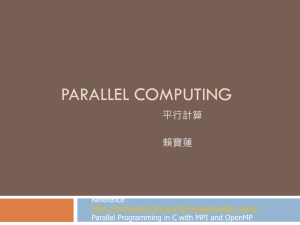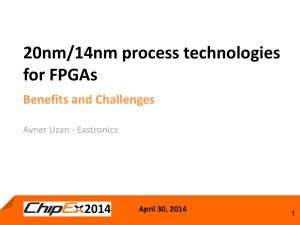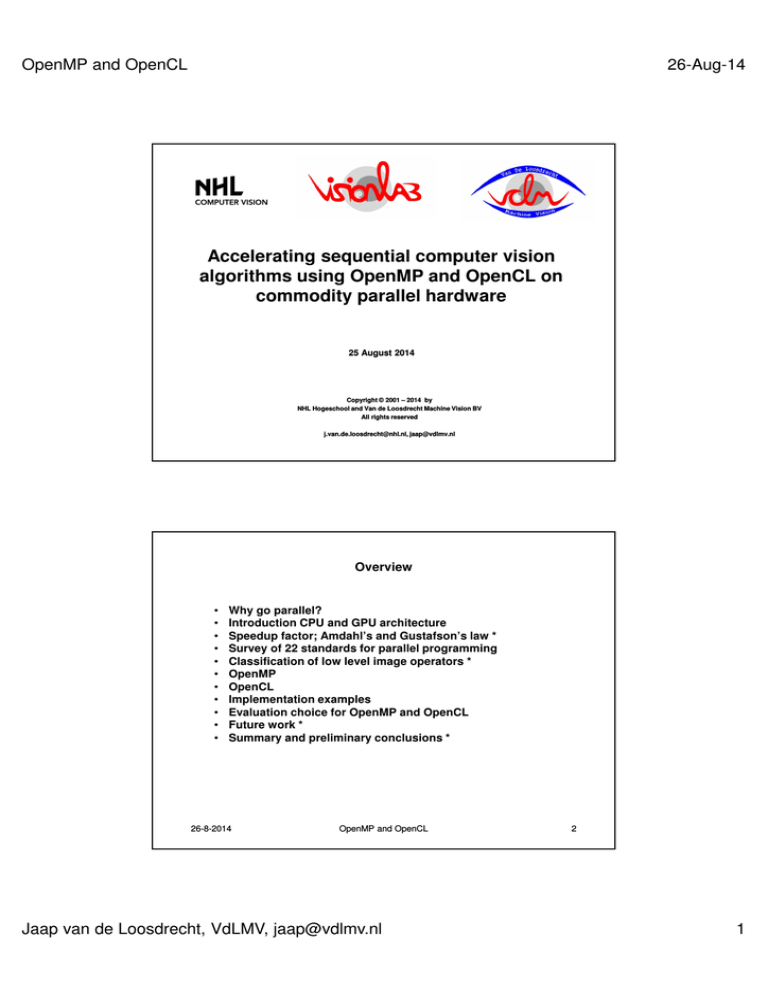
OpenMP and OpenCL
26-Aug-14
Accelerating sequential computer vision
algorithms using OpenMP and OpenCL on
commodity parallel hardware
25 August 2014
Copyright © 2001 – 2014 by
NHL Hogeschool and Van de Loosdrecht Machine Vision BV
All rights reserved
j.van.de.loosdrecht@nhl.nl, jaap@vdlmv.nl
Overview
•
•
•
•
•
•
•
•
•
•
•
Why go parallel?
Introduction CPU and GPU architecture
Speedup factor; Amdahl’s and Gustafson’s law *
Survey of 22 standards for parallel programming
Classification of low level image operators *
OpenMP
OpenCL
Implementation examples
Evaluation choice for OpenMP and OpenCL
Future work *
Summary and preliminary conclusions *
26-8-2014
OpenMP and OpenCL
Jaap van de Loosdrecht, VdLMV, jaap@vdlmv.nl
2
1
OpenMP and OpenCL
26-Aug-14
Why go parallel?
Motivation:
• From 2004 onwards the clock frequency of CPUs has not
increased significantly
• Computer Vision applications have an increasing demand for
more processing power
• The only way to get more performance is to go for parallel
programming
Apply parallel programming techniques to meet the challenges
posed in computer vision by the limits of sequential architectures
26-8-2014
OpenMP and OpenCL
3
Parallelizing VisionLab
Aims and objectives:
• Compare existing programming languages and environments
for parallel computing
• Choose one standard for Multi-core CPU programming and for
GPU programming
• Re-implement a number of standard and well-known
algorithms
• Compare performance to existing sequential implementation
of VisionLab
• Evaluate test results, benefits and costs of parallel approaches
to implementation of computer vision algorithms
26-8-2014
OpenMP and OpenCL
Jaap van de Loosdrecht, VdLMV, jaap@vdlmv.nl
4
2
OpenMP and OpenCL
26-Aug-14
Related research
Other research projects:
• Quest for one domain specific algorithm to compare the best
sequential with best parallel implementation on a specific
hardware
• Framework for auto parallelisation or vectorization
In research, not yet generic applicable
This project is distinctive:
• Investigate how to speedup a Computer Vision library by
parallelizing the algorithms in an economical way and execute
them on multiple platforms
• 100.000 lines of ANSI C++ code
• Generic library
• Portability and vendor independency
• Variance in execution times
• Run time prediction if parallelization is beneficial
See lecture “Multi-core CPU processing in VisionLab”
26-8-2014
OpenMP and OpenCL
5
Introduction CPU and GPU architecture
Observations:
• The last years CPUs do not much become faster than
about 4 GHz
• Multi-core CPU PCs are now widely available at low costs
• Graphics cards (GPUs) have much more computing power
than CPUs and are available at low costs
“The Free Lunch Is Over: A Fundamental Turn Toward
Concurrency in Software” Sutter (2005) predicted that the only
way to get more processing power in the future, is to go for
parallel programming, and that it is not going to be an easy way
26-8-2014
OpenMP and OpenCL
Jaap van de Loosdrecht, VdLMV, jaap@vdlmv.nl
6
3
OpenMP and OpenCL
26-Aug-14
Floating point operations per second comparison between
CPU and GPU
After OpenCL programming guide for CUDA architecture, NVIDIA, 2010
26-8-2014
OpenMP and OpenCL
7
Bandwidth comparison between CPU and GPU
After OpenCL programming guide for CUDA architecture, NVIDIA, 2010
26-8-2014
OpenMP and OpenCL
Jaap van de Loosdrecht, VdLMV, jaap@vdlmv.nl
8
4
OpenMP and OpenCL
26-Aug-14
Floating point operations per second comparison between
CPU and GPU
After The Heterogeneous System architecture its (not) all about the GPU, Blinzer, P., 2014
26-8-2014
OpenMP and OpenCL
9
Flynn's taxonomy
•
Single Instruction, Single Data stream (SISD)
•
Single Instruction, Multiple Data stream (SIMD)
•
Multiple Instruction, Single Data stream (MISD)
•
Multiple Instruction, Multiple Data stream (MIMD)
Wavefront array architectures (GPUs) are a specialization of SIMD
26-8-2014
OpenMP and OpenCL
Jaap van de Loosdrecht, VdLMV, jaap@vdlmv.nl
10
5
OpenMP and OpenCL
26-Aug-14
Flynn's taxonomy
After en.wikipedia.org/wiki/Flynn's_taxonomy
26-8-2014
OpenMP and OpenCL
11
Usage of transistors on chip
After OpenCL programming guide for CUDA architecture, NVIDIA, 2010
26-8-2014
OpenMP and OpenCL
Jaap van de Loosdrecht, VdLMV, jaap@vdlmv.nl
12
6
OpenMP and OpenCL
26-Aug-14
CPU architecture
Designed for a wide variety of applications and to provide fast
response times to a single task
• Multi-core MIMD architecture with
• Branch prediction
• Out-of-order execution
• Super-scalar
• Each core SIMD vector processor
• Complex hierarchy of cache memory with cache coherence
• Restricted by thermal envelope
26-8-2014
OpenMP and OpenCL
13
GPU architecture
Designed for throughput
•
•
•
•
•
Device architecture
GPU memory hierarchy
Warps or wavefronts
Coalesced memory access of global memory *
Bank conflicts in accessing local memory *
26-8-2014
OpenMP and OpenCL
Jaap van de Loosdrecht, VdLMV, jaap@vdlmv.nl
14
7
OpenMP and OpenCL
26-Aug-14
Host and device
After The OpenCL Specification V1.1, A. Munshi, 2011
26-8-2014
OpenMP and OpenCL
15
Device architecture (OpenCL)
After The OpenCL Specification V1.1, A. Munshi, 2011
26-8-2014
OpenMP and OpenCL
Jaap van de Loosdrecht, VdLMV, jaap@vdlmv.nl
16
8
OpenMP and OpenCL
26-Aug-14
GPU memory hierarchy
Compute device memory
• Accessible by all processor elements
• Largest memory
• Slowest access time
• Divided into a global memory part with read/write access and a
constant memory part with only read access
Local memory
• Only accessible by the processor elements in a compute unit
• Available in lesser quantities than compute global memory but in
larger quantity than private memory
• Faster access time than global memory but slower than private
memory
Private memory
• Only accessible by one processor element
• Available only in very limited quantity
• Fastest access time
26-8-2014
OpenMP and OpenCL
17
GPU architecture example
ATI Radeon 5750 GPU (100 euro, September 2011)
• 9 compute units with each 16 processor elements
• Each processor element is a five-way very long instruction
word (VLIW) SIMD like vector processor
• One of the five sub-processors can execute transcendental
instructions
• 9 x 16 x 5 = 720 sub-processors
• Running at 700 Mhz, a peak performance of 1008 GFlops.
• 1 GByte global memory, peak bandwidth of 74 GBytes/s
• 32 KByte local memory for each compute unit, peak bandwidth
of 806 GBytes/s
• 1024 registers of private memory for each processor element,
peak bandwidth of 4838 GBytes/s
26-8-2014
OpenMP and OpenCL
Jaap van de Loosdrecht, VdLMV, jaap@vdlmv.nl
18
9
OpenMP and OpenCL
26-Aug-14
Warps or wavefronts
• Work-items are organised in workgroups
• Work-items in a workgroup are organized in warps
• A work-item has
• Global id
• Workgroup id
• Local id
26-8-2014
OpenMP and OpenCL
19
NDRange, Work-Groups and Wavefronts
After AMD Accelerated Parallel Processing
OpenCL Programming GuideAMD, 2011
26-8-2014
OpenMP and OpenCL
Jaap van de Loosdrecht, VdLMV, jaap@vdlmv.nl
20
10
OpenMP and OpenCL
26-Aug-14
Warps or wavefronts
• All work-items in a warp execute the same instruction in
parallel on all cores of a compute unit (SIMT)
• Typical size for a warp is 16, 32 or 64 work-items
• Branch divergence
26-8-2014
OpenMP and OpenCL
21
Branch divergence
After Optimizing CUDA Applications, van Oosten, J., 2011
26-8-2014
OpenMP and OpenCL
Jaap van de Loosdrecht, VdLMV, jaap@vdlmv.nl
22
11
OpenMP and OpenCL
26-Aug-14
Warps or wavefronts
• All work-items in a warp execute the same instruction in
parallel on all cores of a compute unit (SIMT)
• Typical size for a warp is 16, 32 or 64 work-items
• Branch divergence
• Occupancy rate
Hide long global memory latency
• Zero-overhead warp scheduling
26-8-2014
OpenMP and OpenCL
23
Non-coalesced memory access of global memory
Example for warp with four work-items and chunk size = 4
local work item id
0
0
0
0
1
1
1
1
2
2
2
2
3
3
3
3
Global memory
26-8-2014
OpenMP and OpenCL
Jaap van de Loosdrecht, VdLMV, jaap@vdlmv.nl
24
12
OpenMP and OpenCL
26-Aug-14
Coalesced memory access of global memory
Example for warp with four work-items and chunk size = 4
local work item id
0
1
2
3
0
1
2
3
0
1
2
3
0
1
2
3
Global memory
26-8-2014
OpenMP and OpenCL
25
Bank conflicts in accessing local memory
In order to access fast local memory
• Divided in banks
• Dedicated channels
• Successive N words are assigned to successive banks
26-8-2014
OpenMP and OpenCL
Jaap van de Loosdrecht, VdLMV, jaap@vdlmv.nl
26
13
OpenMP and OpenCL
26-Aug-14
Bank conflicts in accessing local memory
After CUDA Tutorial, NVIDIA, 2008
26-8-2014
OpenMP and OpenCL
27
Bank conflicts in accessing local memory
After CUDA Tutorial, NVIDIA, 2008
26-8-2014
OpenMP and OpenCL
Jaap van de Loosdrecht, VdLMV, jaap@vdlmv.nl
28
14
OpenMP and OpenCL
26-Aug-14
HSA Roadmap
After P. Rogers, AMD 2012
26-8-2014
OpenMP and OpenCL
29
Speedup factor
T1 = execution time with one core
TN = execution time with N cores
Speedup factor = T1 / TN
P = time spent in the fraction of the program that can be parallelized
S = time spent in the serial fraction
Example: if 80% of the code can be parallelized then the speedup <= 5
26-8-2014
OpenMP and OpenCL
Jaap van de Loosdrecht, VdLMV, jaap@vdlmv.nl
30
15
OpenMP and OpenCL
26-Aug-14
Amdahl’s law: speedup for 1024 cores
After: Gustafson, Montry and Benner, 1988
26-8-2014
OpenMP and OpenCL
31
Gustafson’s law
•
•
More processors and memory: many problems are scaled with N
Problem is scaled: in many cases S decreases
•
Amdahl’s law: how fast a given serial program would run on a
parallel system
•
Gustafson’s law: how long a given parallel program would run on
a sequential processor
Speedup Gustafson =
26-8-2014
S + P*N
= N − ( N − 1) * S
S+P
OpenMP and OpenCL
Jaap van de Loosdrecht, VdLMV, jaap@vdlmv.nl
32
16
OpenMP and OpenCL
26-Aug-14
Gustafson’s law: speedup for 1024 cores
After: Gustafson, Montry and Benner, 1988
26-8-2014
OpenMP and OpenCL
33
Heterogeneous architecture
Heterogeneous = combination of CPU and GPU
Example:
•
•
10% of code can not be parallelized
1 core needs 10 times as many resources to be 2 x faster
• SpeedupAmdahl with 100 simple cores
1 / (0.1 + 0.9/100) = 9.2
• SpeedupAmdahl with 90 simple cores and one 2 x faster core
1 / (0.1/2 + 0.9/90) = 16.7
After Asanovic et al., 2006
26-8-2014
OpenMP and OpenCL
Jaap van de Loosdrecht, VdLMV, jaap@vdlmv.nl
34
17
OpenMP and OpenCL
26-Aug-14
Survey of 22 standards for parallel programming
GPU and heterogeneous programming:
• Accelerator
• CUDA
• C++ AMP
• Direct Compute
• HMPP Workbench
• Liquid Metal
• OpenACC
• OpenCL
• PGI Accelerator
• SaC
• Shader languages
Multi-core CPU:
• Array Building Blocks
• C++11 Threads
• Cilk Plus
• MCAPI
• MPI
• OpenMP
• Parallel Building Blocks
• Parallel Patterns Library
• Posix Threads
• PVM
• Thread Building Blocks
26-8-2014
OpenMP and OpenCL
35
Choice of standard for multi-core CPU programming
Requirement
Industry
----------------
standard
Maturity
Acceptance by Future
Vendor
market
independence
developments
Portability
Standard
Array Building No
Beta
Blocks
C++11
Vector
Effort for
capabilities
conversion
(optional)
(optional)
Good
Poor
Poor
No
Yes
Huge
Good
Good
Good
No
No
Huge
Reasonable
Reasonable
No
Yes
Low
not ranked
Yes
Partly new
Threads
Cilk Plus
New,
Scalable to
ccNUMA
New,
not ranked
No
Good
Rank 6
Good
No MSVC
MCAPI
No
Poor
Not ranked
Unknown
Good
Good
Yes
No
Huge
MPI
Yes
Excellent
Rank 7
Good
Good
Good
Yes
No
Huge
OpenMP
Yes
Excellent
Rank 1
Good
Good
Good
Yes,
No
Low
only GNU
Parallel
Patterns
No
Reasonable
Library
New,
Good
not ranked
Posix Threads Yes
Poor
Poor
No
No
Huge
Only MSVC
Excellent
Not ranked
Poor
Good
Good
No
No
Huge
Good
Rank 3
Good
Reasonable
Reasonable
No
No
Huge
Thread
Building
No
Blocks
26-8-2014
OpenMP and OpenCL
Jaap van de Loosdrecht, VdLMV, jaap@vdlmv.nl
36
18
OpenMP and OpenCL
26-Aug-14
Choice of standard for GPU programming
Requirement Industry
---------------
Maturity
standard
Acceptance by
Future
Expected
Hardware
Software
market
developments
familiarization
vendor
vendor
time
independence
independence
Standard
Portability
Heterogeneous
C++ AMP
No
New
Not ranked
Unknown
Medium
Bad
Bad
Poor
No
CUDA
No
Excellent
Rank 5
Good
High
Reasonable
Reasonable
Bad
No
Direct
No
Poor
Not ranked
Unknown
High
Bad
Bad
Bad
No
No
Poor
Not ranked
Plan for open
Medium
Reasonable
Bad
Good
Yes
Compute
HMPP
standard
OpenCL
Yes
Good
Rank 2
Good
High
Good
Good
Good
Yes
No
Reasonable
Not ranked
Unknown
Medium
Bad
Bad
Bad
No
PGI
Accelerator
26-8-2014
OpenMP and OpenCL
37
Acceptance by market
After R, Bergman, AMD 2011
26-8-2014
OpenMP and OpenCL
Jaap van de Loosdrecht, VdLMV, jaap@vdlmv.nl
38
19
OpenMP and OpenCL
26-Aug-14
New developments
• CUDA less vendor/platform specific, but no industry standard
• Visual Studio 2012 C++ AMP, great tool but vendor specific
• Enhancement OpenCL kernel language, C++ like features like
classes and templates, only AMD implementation
• Altera Corporation OpenCL program for FPGAs
• OpenACC announced and products available
• Announced OpenMP 4.0 with “directives for attached accelerators”
Portable OpenMP pragma style programming on multi-core CPUs and GPUs, utilize
vector capabilities of CPUs and GPUs
26-8-2014
OpenMP and OpenCL
39
Classification of low level image operators
Classification by Nicolescu and Jonker (2001) and Kiran, Anoop
and Kumar (2011)
Class
Example
Point operator
Threshold
Global operator
Histogram
Local neighbour operator
Convolution
Connectivity based operator Label Blobs
26-8-2014
OpenMP and OpenCL
Jaap van de Loosdrecht, VdLMV, jaap@vdlmv.nl
40
20
OpenMP and OpenCL
26-Aug-14
Parallelizing a large generic computer vision library
Idea to parallelize large part of the library:
• One instance of each low level class is implemented and can
be used as skeleton to implement other instances of class
• Many high level operators are built on the low level operators
Other operators are special and need will need a dedicated
approach to parallelizing
26-8-2014
OpenMP and OpenCL
41
OpenMP
•
•
•
•
•
Introduction
Components
Scheduling strategy *
Memory model *
Examples
See for standard: www.openmp.org
26-8-2014
OpenMP and OpenCL
Jaap van de Loosdrecht, VdLMV, jaap@vdlmv.nl
42
21
OpenMP and OpenCL
26-Aug-14
OpenMP introduction
• An API that supports multi-platform shared memory
multiprocessing programming in C, C++ and Fortran
• Supports both data parallel and task parallel multiprocessing
• Fork-join programming model
After Introduction to Parallel Computing, Barney, 2011
26-8-2014
OpenMP and OpenCL
43
OpenMP example adding two vectors
const int SIZE = 1000;
double a[SIZE], b[SIZE], c[SIZE];
// code for initialising array b and c
#pragma omp for
for (int j = 0; j < SIZE; j++) {
a[j] = b[j] + c[j];
} // for j
Assuming CPU has four cores, at executing time the next events will
happen:
• The master thread forks a team of three threads
• All four threads will execute in parallel one quarter of the for loop. The
first thread will execute the for loop for 0 <= j < 250, the second thread
will execute the for loop for
250 <= j < 500, etc
• When all threads have completed their work the threads will join
26-8-2014
Multi Core Processing in
VisionLab
Jaap van de Loosdrecht, VdLMV, jaap@vdlmv.nl
44
22
OpenMP and OpenCL
26-Aug-14
OpenMP Components
OpenMP consists of three major components:
• Compiler directives
• Runtime functions and variables
• Environment variables
26-8-2014
OpenMP and OpenCL
45
OpenMP compiler directives
All compiler directives start with “#pragma omp”. There are
compiler directives for expressing the type of parallelism:
• For loop directive for data parallelism
• Parallel regions directive for task parallelism
• Single and master directives for sequential executing of code
in parallel constructs
There are also compiler directives for synchronisation primitives,
like:
• Atomic variables
• Barriers
• Critical sections
• Flushing (synchronizing) memory and caches between threads
26-8-2014
OpenMP and OpenCL
Jaap van de Loosdrecht, VdLMV, jaap@vdlmv.nl
46
23
OpenMP and OpenCL
26-Aug-14
OpenMP runtime functions and variables
OpenMP has runtime functions for performing operations like:
• Locking
• Querying and setting the number of threads to be used in
parallel regions
• Time measurement
• Setting the scheduling strategy
With environment variables it is possible to modify the default
behaviour of OpenMP, like:
• Setting the maximal number of threads to be used in parallel
regions
• Setting the stack size for the threads
• Setting the scheduling strategy
26-8-2014
OpenMP and OpenCL
47
OpenMP scheduling strategy
• Static: iterations are divided into chunks of size chunk_size,
and the chunks are assigned to the threads in the team in a
round-robin fashion in the order of the thread number.
• Dynamic: iterations are distributed to threads in the team in
chunks as the threads request them. Each thread executes a
chunk of iterations, then requests another chunk, until no
chunks remain to be distributed .
• Guided: iterations are assigned to threads in the team in
chunks as the executing threads request them. Each thread
executes a chunk of iterations, then requests another chunk,
until no chunks remain to be assigned. The size of the chunk
decreases each time.
• Auto: decision regarding scheduling is delegated to the
compiler and/or runtime system.
26-8-2014
OpenMP and OpenCL
Jaap van de Loosdrecht, VdLMV, jaap@vdlmv.nl
48
24
OpenMP and OpenCL
26-Aug-14
OpenMP memory model
The OpenMP API provides a relaxed-consistency, shared-memory
model:
• Each thread is allowed to have its own temporary view of the
memory. The memory model has relaxed-consistency because
a thread’s temporary view of memory is not required to be
consistent with memory at all times.
• A flush operation enforces consistency between the temporary
view and memory.
The flush operation:
• Can be specified using the flush directive
• Is implied at:
• A barrier region
• At entry to and exit from parallel and critical region
26-8-2014
OpenMP and OpenCL
49
Sequential Threshold
template <class OrdImageT, class PixelT>
void Threshold (OrdImageT &image, const PixelT low, const PixelT high) {
PixelT *pixelTab = image.GetFirstPixelPtr();
const int nrPixels = image.GetNrPixels();
for (int i = 0; i < nrPixels; i++) {
pixelTab[i] = ((pixelTab[i] >= low) && (pixelTab[i] <= high))
? OrdImageT::Object() : OrdImageT::BackGround();
} // for all pixels
} // Threshold
26-8-2014
OpenMP and OpenCL
Jaap van de Loosdrecht, VdLMV, jaap@vdlmv.nl
50
25
OpenMP and OpenCL
26-Aug-14
OpenMP Threshold
template <class OrdImageT, class PixelT>
void Threshold (OrdImageT &image, const PixelT low, const PixelT high) {
PixelT *pixelTab = image.GetFirstPixelPtr();
int nrPixels = image.GetNrPixels();
#pragma omp parallel for
for (int i = 0; i < nrPixels; i++) {
pixelTab[i] = ((pixelTab[i] >= low) && (pixelTab[i] <= high))
? OrdImageT::Object() : OrdImageT::BackGround();
} // for all pixels
} // Threshold
26-8-2014
OpenMP and OpenCL
51
OpenMP Threshold speedup graph on i7 2600 (4 cores)
26-8-2014
OpenMP and OpenCL
Jaap van de Loosdrecht, VdLMV, jaap@vdlmv.nl
52
26
OpenMP and OpenCL
26-Aug-14
Sequential Histogram
template <class IntImageT>
void Histogram0 (const IntImageT &image, const int hisSize, int *his) {
typedef typename IntImageT::PixelType PixelT;
memset(his, 0, hisSize * sizeof(int));
PixelT *pixelTab = image.GetFirstPixelPtr();
const int nrPixels = image.GetNrPixels();
for (int i = 0; i < nrPixels; i++) {
his[pixelTab[i]]++;
} // for i
} // Histogram0
26-8-2014
OpenMP and OpenCL
53
OpenMP Histogram
Pseudo code
• Clear global histogram
• Split image in N parts and do in parallel for each part
• Create and clear local histogram
• Calculate local histogram
• Add all local histograms to global histogram
26-8-2014
OpenMP and OpenCL
Jaap van de Loosdrecht, VdLMV, jaap@vdlmv.nl
54
27
OpenMP and OpenCL
26-Aug-14
OpenMP Histogram
template <class IntImageT>
void Histogram0 (const IntImageT &image, const int hisSize, int *his) {
typedef typename IntImageT::PixelType PixelT;
memset(his, 0, hisSize * sizeof(int));
PixelT *pixelTab = image.GetFirstPixelPtr();
const int nrPixels = image.GetNrPixels();
#pragma omp parallel
{
int *localHis = new int[hisSize];
memset(localHis, 0, hisSize * sizeof(int));
#pragma omp for nowait
for (int i = 0; i < nrPixels; i++) {
localHis[pixelTab[i]]++;
} // for i
#pragma omp critical (CalcHistogram0)
{
for (int h = 0; h < hisSize; h++) {
his[h] += localHis[h];
} // for h
} // omp critical
delete [] localHis;
} // omp parallel
} // Histogram0
26-8-2014
OpenMP and OpenCL
55
OpenMP Histogram speedup graph on i7 2600 (4 cores)
26-8-2014
OpenMP and OpenCL
Jaap van de Loosdrecht, VdLMV, jaap@vdlmv.nl
56
28
OpenMP and OpenCL
26-Aug-14
OpenMP Convolution speedup graph on i7 2600 (4 cores)
26-8-2014
OpenMP and OpenCL
57
OpenMP LabelBlobs speedup graph on i7 2600 (4 cores)
26-8-2014
OpenMP and OpenCL
Jaap van de Loosdrecht, VdLMV, jaap@vdlmv.nl
58
29
OpenMP and OpenCL
26-Aug-14
OpenCL
• OpenCL architecture *
• Platform model
• Execution model
• Memory model
• Programming model
• Kernel language
• Host API
• Examples
• Memory transfer *
See for standard: www.khronos.org/opencl
26-8-2014
OpenMP and OpenCL
59
OpenCL platform model
The model consists of a host connected to one or more OpenCL
devices. An OpenCL device is divided into one or more compute
units which are further divided into one or more processing
elements. Computations on a device occur within the processing
elements.
After The OpenCL Specification V1.1, A. Munshi, 2011
26-8-2014
OpenMP and OpenCL
Jaap van de Loosdrecht, VdLMV, jaap@vdlmv.nl
60
30
OpenMP and OpenCL
26-Aug-14
OpenCL execution model
Execution of an OpenCL program occurs in two parts:
• Kernels that execute on one or more OpenCL devices
• A host program that executes on the host
26-8-2014
OpenMP and OpenCL
61
OpenCL execution model
When the kernel is submitted to the compute device for
computation an indexing space is defined
26-8-2014
OpenMP and OpenCL
Jaap van de Loosdrecht, VdLMV, jaap@vdlmv.nl
62
31
OpenMP and OpenCL
26-Aug-14
NDRange, Work-Groups and Wavefronts
After AMD Accelerated Parallel Processing
OpenCL Programming GuideAMD, 2011
26-8-2014
OpenMP and OpenCL
63
OpenCL execution model
When the kernel is submitted to the compute device for
computation an indexing space is defined
An instance of the kernel, called work-item is created for each
index
• Work-item has a unique global ID
• Work-items are organized into work-groups
• All work-items of one work-group execute concurrently on the
processing elements of a single compute unit
• Work-group has a unique work-group ID
• Work-item has a unique local ID within a work-group
The indexing space is called NDRange (N-Dimensional Range)
OpenCL supports up to and including three dimensional indexing
26-8-2014
OpenMP and OpenCL
Jaap van de Loosdrecht, VdLMV, jaap@vdlmv.nl
64
32
OpenMP and OpenCL
26-Aug-14
OpenCL execution model
The host program defines the context for the kernels and
manages their execution. The context includes:
• Devices
• Program objects (source and executables)
• Memory objects (buffers, images, queues and events)
• Kernels (OpenCL functions that run on devices)
The host places commands into the command-queue which are
then scheduled onto the devices within the context:
• Kernel execution commands: execute a kernel on the
processing elements of a device
• Memory commands: transfer data to, from, or between
memory objects
• Synchronization commands: constrain the order of execution
of commands
26-8-2014
OpenMP and OpenCL
65
OpenCL execution model
After OpenCL A Standard platform for programming Heterogeneous parallel computers,
Mattson et al, 2009
26-8-2014
OpenMP and OpenCL
Jaap van de Loosdrecht, VdLMV, jaap@vdlmv.nl
66
33
OpenMP and OpenCL
26-Aug-14
OpenCL memory model
After The OpenCL Specification V1.1, A. Munshi, 2011
26-8-2014
OpenMP and OpenCL
67
OpenCL memory model
• Global Memory: permits read/write access to all work-items in
all work-groups
• Constant Memory: global memory initialized by host that
remains constant during the execution of a kernel
• Local Memory: memory local to a work-group, variables are
shared by all work-items in that work-group
• Private Memory: memory private to a work-item
26-8-2014
OpenMP and OpenCL
Jaap van de Loosdrecht, VdLMV, jaap@vdlmv.nl
68
34
OpenMP and OpenCL
26-Aug-14
OpenCL programming model
Programming models
• Supports data parallel and task parallel
• Primary model driving the design is data parallel
Synchronization
• In kernels
• Work-items in a single work-group using a barrier
• No mechanism for synchronization between work-groups
• Using host API
• Command-queue barrier, commands enqueued to
command-queue(s) in a single context
• Using events
26-8-2014
OpenMP and OpenCL
69
OpenCL kernel language
Subset of ISO C99 with extensions
• No function pointers, recursion, bit fields, variable-length
arrays and standard C99 header files
• Extensions: vector types, synchronization, functions to work
with work-items/groups, etc
Kernel for adding of two vectors
kernel void VecAdd (global int* c, global int* a, global int* b) {
unsigned int n = get_global_id(0);
c[n] = a[n] + b[n];
}
26-8-2014
OpenMP and OpenCL
Jaap van de Loosdrecht, VdLMV, jaap@vdlmv.nl
70
35
OpenMP and OpenCL
26-Aug-14
OpenCL Host API
For adding of two vectors (67 C statements, without error checking code)
• Allocate space for vectors and initialize
• Discover and initialize OpenCL platform
• Discover and initialize compute device
• Create a context
• Create a command queue
• Create device buffers
• Create and compile the program
• Create the kernel
• Set the kernel arguments
• Configure the NDRange
• Write host data to device buffers
• Enqueue the kernel for execution
• Read the output buffer back to the host
• Verify result
• Release OpenCL and host resources
26-8-2014
OpenMP and OpenCL
71
OpenCL Threshold kernel
One pixel or vector of pixels per kernel
kernel void Threshold (global ImageT* image, const PixelT low,
const PixelT high) {
const PixelT object = 1;
const PixelT background = 0;
const unsigned int i = get_global_id(0);
image[i] = ((image[i] >= low) && (image[i] <= high)) ?
object : background;
} // Threshold
“Poor man’s” template for Int16Image:
• ImageT = short, short4, short8 or short16
• PixelT = short
26-8-2014
OpenMP and OpenCL
Jaap van de Loosdrecht, VdLMV, jaap@vdlmv.nl
72
36
OpenMP and OpenCL
26-Aug-14
OpenCL Threshold host side VisionLab script
CL_Init NVIDIA GPU
$contextId = CL_CreateContext 0 (0)
$qId = CL_CreateQueue $contextId 0 OutOfOrderDisabled ProfilingDisabled
$zrc = VarFromFile threshold.cl
$programId = CL_CreateProgram $contextId &$zrc
$bufId = CL_CreateBuffer $contextId ReadWrite ImageBuffer par
$options = "-DPixelT=short -DImageT=short"
CL_Build $programId &$options
CL_AddKernel $programId Threshold
CL_SetArg Threshold 0 Buffer $bufId
CL_SetArg Threshold 1 Short $low
CL_SetArg Threshold 2 Short $high
CL_WriteBuffer $qId $bufId par () () Wait
CL_Run $qId Threshold () ($nrPixels) () () () Wait
CL_ReadBuffer $qId $bufId par () () Wait
26-8-2014
OpenMP and OpenCL
73
OpenCL development in VisionLab
Jaap van de Loosdrecht, VdLMV, jaap@vdlmv.nl
37
OpenMP and OpenCL
26-Aug-14
OpenCL development in VisionLab
OpenCL Threshold GPU speedup graph (GTX 560 Ti)
One pixel or vector of pixels per kernel
26-8-2014
OpenMP and OpenCL
Jaap van de Loosdrecht, VdLMV, jaap@vdlmv.nl
76
38
OpenMP and OpenCL
26-Aug-14
OpenCL Threshold CPU speedup graph (i7 2600)
One pixel or vector of pixels per kernel
26-8-2014
OpenMP and OpenCL
77
OpenCL Threshold kernel
Chunk of pixels or vectors of pixels per kernel
kernel void ThresholdChunk (
global ImageT* image,
const PixelT low, const PixelT high,
const unsigned int size) {
const PixelT object = 1;
const PixelT background = 0;
unsigned int i = get_global_id(0) * size;
const unsigned int last = i + size;
for (; i < last; i++) {
image[i] = ((image[i] >= low) && (image[i] <= high)) ?
object : background;
} // for i
} // ThresholdChunck
26-8-2014
OpenMP and OpenCL
Jaap van de Loosdrecht, VdLMV, jaap@vdlmv.nl
78
39
OpenMP and OpenCL
26-Aug-14
Non-coalesced memory access of global memory
Example for warp with four work-items and chunk size = 4
local work item id
0
0
0
0
1
1
1
1
2
2
2
2
3
3
3
3
Global memory
26-8-2014
OpenMP and OpenCL
79
Coalesced memory access of global memory
Example for warp with four work-items and chunk size = 4
local work item id
0
1
2
3
0
1
2
3
0
1
2
3
0
1
2
3
Global memory
26-8-2014
OpenMP and OpenCL
Jaap van de Loosdrecht, VdLMV, jaap@vdlmv.nl
80
40
OpenMP and OpenCL
26-Aug-14
OpenCL Threshold kernel
One pixel or vector of pixels per kernel with coalesced access
kernel void ThresholdCoalChunk (global ImageT* image,
const PixelT low, const PixelT high,
const unsigned int size) {
const PixelT object = 1;
const PixelT background = 0;
const unsigned int gid = get_group_id(0);
const unsigned int lid = get_local_id(0);
const unsigned int ws = get_local_size(0);
unsigned int i = (gid * ws * size) + lid;
const unsigned int last = i + size * ws;
for (; i < last; i += ws) {
image[i] = ((image[i] >= low) && (image[i] <= high)) ?
object : background;
} // for i
} // ThresholdCoalChunk
26-8-2014
OpenMP and OpenCL
81
OpenCL Threshold GPU speedup graph (GTX 560 Ti)
Chunk of pixels or vectors of pixels per kernel
26-8-2014
OpenMP and OpenCL
Jaap van de Loosdrecht, VdLMV, jaap@vdlmv.nl
82
41
OpenMP and OpenCL
26-Aug-14
OpenCL Threshold CPU speedup graph (i7 2600)
Chunk of pixels or vectors of pixels per kernel
26-8-2014
OpenMP and OpenCL
83
Threshold OpenMP versus OpenCL
26-8-2014
OpenMP and OpenCL
Jaap van de Loosdrecht, VdLMV, jaap@vdlmv.nl
84
42
OpenMP and OpenCL
26-Aug-14
OpenCL Histogram
After Gaster et al., 2012, chapter 9
26-8-2014
OpenMP and OpenCL
85
OpenCL Histogram kernel (part 1)
kernel void HistogramKernel (const global short *image,
const uint nrPixels, const uint hisSize,
local int *localHis, global int *histogram) {
const uint globalId = get_global_id(0);
const uint localId = get_local_id(0);
const uint localSize = get_local_size(0);
const uint groupId = get_group_id(0);
const uint numGroups = get_num_groups(0);
// clear localHis
const uint maxThreads = MIN(hisSize, localSize);
const uint binsPerThread = hisSize / maxThreads;
uint i, idx;
if (localId < maxThreads) {
for (i = 0, idx = localId; i < binsPerThread;
i++, idx += maxThreads) {
localHis[idx] = 0;
}
}
barrier(CLK_LOCAL_MEM_FENCE);
26-8-2014
OpenMP and OpenCL
Jaap van de Loosdrecht, VdLMV, jaap@vdlmv.nl
86
43
OpenMP and OpenCL
26-Aug-14
OpenCL Histogram kernel (part 2)
// calculate local histogram
const uint pixelsPerGroup = nrPixels / numGroups;
const uint pixelsPerThread = pixelsPerGroup / localSize;
const uint stride = localSize;
for (i = 0, idx = (groupId * pixelsPerGroup) + localId;
i < pixelsPerThread; i++, idx += stride) {
(void) atom_inc (&localHis[image[idx]]);
}
barrier(CLK_LOCAL_MEM_FENCE);
// copy local histogram to global
if (localId < maxThreads) {
for (i = 0, idx = localId; i < binsPerThread;
i++, idx += maxThreads) {
histogram[(groupId * hisSize) + idx] = localHis[idx];
}
}
} // HistogramKernel
26-8-2014
OpenMP and OpenCL
87
OpenCL Histogram Reduce kernel
kernel void ReduceKernel (const uint nrSubHis, const uint hisSize,
global int *histogram) {
const uint gid = get_global_id(0);
int bin = 0;
for (uint i=0; i < nrSubHis; i++)
bin += histogram[(i * hisSize) + gid];
histogram[gid] = bin;
} // ReduceKernel
26-8-2014
OpenMP and OpenCL
Jaap van de Loosdrecht, VdLMV, jaap@vdlmv.nl
88
44
OpenMP and OpenCL
26-Aug-14
OpenCL Histogram speedup graph(GTX 560 Ti)
26-8-2014
OpenMP and OpenCL
89
OpenCL Histogram speedup graph(i7 2600)
26-8-2014
OpenMP and OpenCL
Jaap van de Loosdrecht, VdLMV, jaap@vdlmv.nl
90
45
OpenMP and OpenCL
26-Aug-14
OpenCL Histogram GPU speedup graph (GTX 560 Ti)
Using multiple local histogram per work-group
26-8-2014
OpenMP and OpenCL
91
OpenCL Histogram GPU speedup graph (GTX 560 Ti)
with 16 local histograms
26-8-2014
OpenMP and OpenCL
Jaap van de Loosdrecht, VdLMV, jaap@vdlmv.nl
92
46
OpenMP and OpenCL
26-Aug-14
OpenCL Histogram GPU speedup graph (GTX 560 Ti)
1 local histogram per work-group versus 16
26-8-2014
OpenMP and OpenCL
93
Optimized implementation for CPUs
•
•
•
Each workgroup has only one work-item
Number of workgroups is equal to the number of cores
No race conditions for the local histogram, so no need for
expensive atomic increment operations
26-8-2014
OpenMP and OpenCL
Jaap van de Loosdrecht, VdLMV, jaap@vdlmv.nl
94
47
OpenMP and OpenCL
26-Aug-14
OpenCL Histogram optimized for CPU (i7 2600)
26-8-2014
OpenMP and OpenCL
95
Histogram OpenCL versus OpenMP
Jaap van de Loosdrecht, VdLMV, jaap@vdlmv.nl
48
OpenMP and OpenCL
26-Aug-14
OpenCL Convolution GPU speedup graph (GTX 560 Ti)
26-8-2014
OpenMP and OpenCL
97
OpenCL Convolution GPU speedup graph (GTX 560 Ti)
26-8-2014
OpenMP and OpenCL
Jaap van de Loosdrecht, VdLMV, jaap@vdlmv.nl
98
49
OpenMP and OpenCL
26-Aug-14
OpenCL LabelBlobs GPU speedup graph (GTX 560 Ti)
26-8-2014
OpenMP and OpenCL
99
Memory transfer
Memory transfers:
• Normal
• Pinned
• Zero copy (not available for testing)
Data transfers benchmarked:
• From CPU to GPU
• From GPU to CPU
26-8-2014
OpenMP and OpenCL
Jaap van de Loosdrecht, VdLMV, jaap@vdlmv.nl
100
50
OpenMP and OpenCL
26-Aug-14
Data transfer from CPU to GPU (GTX 560 Ti)
26-8-2014
OpenMP and OpenCL
101
Data transfer from GPU to CPU (GTX 560 Ti)
26-8-2014
OpenMP and OpenCL
Jaap van de Loosdrecht, VdLMV, jaap@vdlmv.nl
102
51
OpenMP and OpenCL
26-Aug-14
Overhead data transfer (in ms) is massive
for simple vision operators
26-8-2014
OpenMP and OpenCL
103
Evaluation choice for OpenMP
OpenMP is very well suited for parallelizing many algorithms of a
library in an economical way and execute them with an adequate
speedup on multiple parallel CPU platforms
•
•
•
•
•
•
OpenMP easy to learn
Mature and stable tools
Very low effort embarrassingly parallel algorithms
170 operators parallelized
Automatic operator parallelization
Portability tested on quad core ARM running Linux
26-8-2014
OpenMP and OpenCL
Jaap van de Loosdrecht, VdLMV, jaap@vdlmv.nl
104
52
OpenMP and OpenCL
26-Aug-14
Evaluation choice for OpenCL
OpenCL is not very well suitable for parallelizing all algorithms of
a whole library in an economical way and execute them effective
on multiple platforms
Difficult to learn, new mindset needed
Tools are “in development”
Considerable effort embarrassingly parallel algorithms
Non embarrassingly parallel algorithms need complete new
approaches
• Overhead host – device data transfer
•
•
•
•
•
•
•
•
Considerable speedups possible
Exploitation vector capabilities CPUs / GPUs
Heterogeneous computing
Portable but the performance is not portable
26-8-2014
OpenMP and OpenCL
105
Standard for GPU and heterogeneous programming
There is at the moment NO suitable standard for parallelizing all
algorithms of a whole library in an economical way and execute
them effective on multiple platforms
OpenCL is still the best choice in this domain
26-8-2014
OpenMP and OpenCL
Jaap van de Loosdrecht, VdLMV, jaap@vdlmv.nl
106
53
OpenMP and OpenCL
26-Aug-14
Recommendations OpenCL
Use for accelerating dedicated algorithms on specific platforms:
• Considerable amount effort writing and optimizing code
• Algorithms are computational expensive
• Overhead data transfer must be relative small compared to
execution time of kernels
• Code optimized for one device or sub optimal speedup
acceptable if run on different similar devices
26-8-2014
OpenMP and OpenCL
107
Future work
New development in standards
• C++ AMP
• OpenMP 4.0
Near future
• Parallelize more vision operators
More distant future
• Intelligent buffer management
• Automatic tuning of parameters
• Heterogeneous computing
26-8-2014
OpenMP and OpenCL
Jaap van de Loosdrecht, VdLMV, jaap@vdlmv.nl
108
54
OpenMP and OpenCL
26-Aug-14
Summary and conclusions
Choice made for standards OpenMP and OpenCL
Integration OpenMP and OpenCL in VisionLab
Benchmark environment
OpenMP
• Embarrassingly parallel algorithms are easy to convert
with adequate speedup
• More than 170 operators parallelized
• Run time prediction implemented
• OpenCL
• “Not an easy road”
• Considerable speedups possible
• Scripting host side code accelerates development time
• Portable functionality
• Portable performance is not easy
•
•
•
•
26-8-2014
OpenMP and OpenCL
Jaap van de Loosdrecht, VdLMV, jaap@vdlmv.nl
109
55

